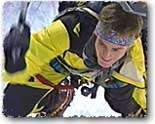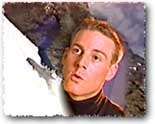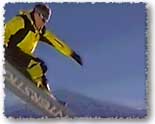

This time, we didn't ask for permission and planned to have the snowboards brought in under cover of darkness. The team — climber and videographer Scott Backes; climber and snowboarder Jason Schutz; McKoy and I met at the Impala Hotel in Arusha, Tanzania where we recovered from our jetlag and got to know each other a little better.
There isn't much activity on this side of Kilimanjaro. It is the Umbwe
route that accesses the Breach Wall, Heim and Southern Glaciers. Our
porters call the routes these "whiskey" routes because they are steeper,
have no fixed huts for climbers and all have at least Grade IV ice
climbing.
The Climb
With its spectacular views of the awesome Breach Wall and the jungle below, we spent our second night in the Borronco Hut Camp at 13,800 feet climbing to camp III at 15,500 feet in the morning. It was here that, as visibility cleared, we were treated to a mountain on fire and saw a couple of pristine lines snaking down from the upper Heim Glacier at 17,500 feet. We made a plan to climb this route later. Jason woke us at 2:45am that morning to say he wasn't able to go up. At dawn we descended to 13,000 feet where we hoped he would recover. But, he only got worse and exhibited signs of pulmonary edema. Our guide and a porter took him down and back to the hotel. We kept hope that he would be able to rejoin us.
As Scott and I climbed higher, the angle varied between 45° and 70— with a mean angle of 50°. As my frontpoints reluctantly bit into the blue ice at 17,500 feet, I thought, "this is impossible to snowboard." But, my desire was pushing me, telling me I could find a way; logic and experience, though, were telling me something entirely different. I had never snowboarded a slope this icy. As we were setting up our main bivy tent at 18,000 feet, a wet, sticky snow began to fall and I was hopeful the accumulation would allow me to make controlled turns or, at least, prevent me from skidding into the abyss. We summitted at 8:30am and not wanting to be seen with a "pleasure device," I left my board at the top of the glacier before going to the summit. There we met Wade who had been climbing for 21 of the last 24 hours. The views were unbelievable — glaciers sitting on dark earth with nowhere to go.
The Descent
The sun soon gave way to fog, which led to 20% visibility, and the sound of my board on the ice was like a front end loader on blacktop. Nevertheless, after a couple hours of descent, we got back to the bivy at 17,800 feet. It was cold and I was stiff and sore. From here on out the slope steepened, eventually smoothing out and becoming more exposed. Now riding with a 25-pound pack, the hardest part was still ahead of me. While I had thoughts of downclimbing, I knew I would have always wondered if I could have done it. I had to try.
The New Route The next day Scott and I again looked to the elegant ice lines we had seen snaking the Heim Glacier and decided we would try a new route on the climber's right. Scott woke with a sick stomach I decided to go it alone. The ice was soft and wet with crumbly rock offering insecure footholds. The most difficult was a 30-foot pillar running with water; my picks pulled through the slushy ice with ease. Around the back of the pillar, I found more solid ice and soon the angle mellowed. Two hundred feet later I came to where the routes split and decided on the one Scott and I had chosen. Climbing the next 50 feet quickly I arrived at the crux, a 60-foot pillar at 17,000 feet which was wet and chandeliery. After some very sticky situations, including having to downclimb the vertical ice when my rope looped on an icicle, I made it. As I rappelled what I had just led I felt very alive and it was then that I decided to name the route "Sick Day." Scott and I had talked about naming it "Rest Day" before he was stricken and, after the perilous climb, the new name seemed appropriate for two reasons. — Stephen Koch, Mountain Zone Contributor
|
|
||||||||||||||||||||||||||||||||||||||||||||||||||||||||||
[Climbing Home][Snowboarding Home]




